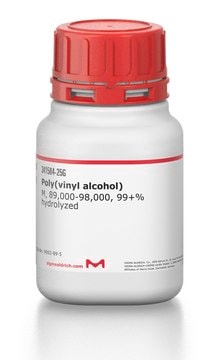If this product has an expiration or retest date, it will be shown on the Certificate of Analysis (COA, CofA). If there is no retest or expiration date listed on the product's COA, we do not have suitable stability data to determine a shelf life. For these products, the only date on the COA will be the release date; a retest, expiration, or use-by-date will not be displayed.
For all products, we recommend handling per defined conditions as printed in our product literature and website product descriptions. We recommend that products should be routinely inspected by customers to ensure they perform as expected.
For products without retest or expiration dates, our standard warranty of 1 year from the date of shipment is applicable.
For more information, please refer to the Product Dating Information document: https://www.sigmaaldrich.com/deepweb/assets/sigmaaldrich/marketing/global/documents/449/386/product-dating-information-mk.pdf
419028
Cellulose acetate
average Mn ~50,000 by GPC
Synonyme(s) :
Acetylcellulose
Sélectionner une taille de conditionnement
86,90 $
Sélectionner une taille de conditionnement
About This Item
86,90 $
Produits recommandés
Forme
powder
Niveau de qualité
Poids mol.
average Mn ~50,000 by GPC
Ampleur du marquage
39.7 wt. % acetyl
Impuretés
≤3.0% water
Indice de réfraction
n20/D 1.475 (lit.)
Densité
1.3 g/mL at 25 °C (lit.)
Chaîne SMILES
O1[C@H](C(C(C(C1COC(=O)C)OC(=O)C)OC(=O)C)OC(=O)C)O[C@@H]2C(OC(C(C2OC(=O)C)OC(=O)C)OC(=O)C)COC(=O)C
InChI
1S/C28H38O19/c1-11(29)37-9-19-21(39-13(3)31)23(40-14(4)32)26(43-17(7)35)28(46-19)47-22-20(10-38-12(2)30)45-27(44-18(8)36)25(42-16(6)34)24(22)41-15(5)33/h19-28H,9-10H2,1-8H3/t19?,20?,21?,22-,23?,24?,25?,26?,27?,28+/m1/s1
Clé InChI
WOTQVEKSRLZRSX-OLIDUAMRSA-N
Vous recherchez des produits similaires ? Visite Guide de comparaison des produits
Catégories apparentées
Description générale
Code de la classe de stockage
11 - Combustible Solids
Classe de danger pour l'eau (WGK)
nwg
Point d'éclair (°F)
Not applicable
Point d'éclair (°C)
Not applicable
Équipement de protection individuelle
Eyeshields, Gloves, type N95 (US)
Faites votre choix parmi les versions les plus récentes :
Certificats d'analyse (COA)
Vous ne trouvez pas la bonne version ?
Si vous avez besoin d'une version particulière, vous pouvez rechercher un certificat spécifique par le numéro de lot.
Déjà en possession de ce produit ?
Retrouvez la documentation relative aux produits que vous avez récemment achetés dans la Bibliothèque de documents.
Les clients ont également consulté
Articles
Electrospinning technique applications discussed, emphasizing control of nanofibers and assembly into 3D architectures.
-
How can I determine the shelf life / expiration / retest date of this product?
1 answer-
Helpful?
-
-
How is shipping temperature determined? And how is it related to the product storage temperature?
1 answer-
Products may be shipped at a different temperature than the recommended long-term storage temperature. If the product quality is sensitive to short-term exposure to conditions other than the recommended long-term storage, it will be shipped on wet or dry-ice. If the product quality is NOT affected by short-term exposure to conditions other than the recommended long-term storage, it will be shipped at ambient temperature. As shipping routes are configured for minimum transit times, shipping at ambient temperature helps control shipping costs for our customers. For more information, please refer to the Storage and Transport Conditions document: https://www.sigmaaldrich.com/deepweb/assets/sigmaaldrich/marketing/global/documents/316/622/storage-transport-conditions-mk.pdf
Helpful?
-
Active Filters
Notre équipe de scientifiques dispose d'une expérience dans tous les secteurs de la recherche, notamment en sciences de la vie, science des matériaux, synthèse chimique, chromatographie, analyse et dans de nombreux autres domaines..
Contacter notre Service technique










